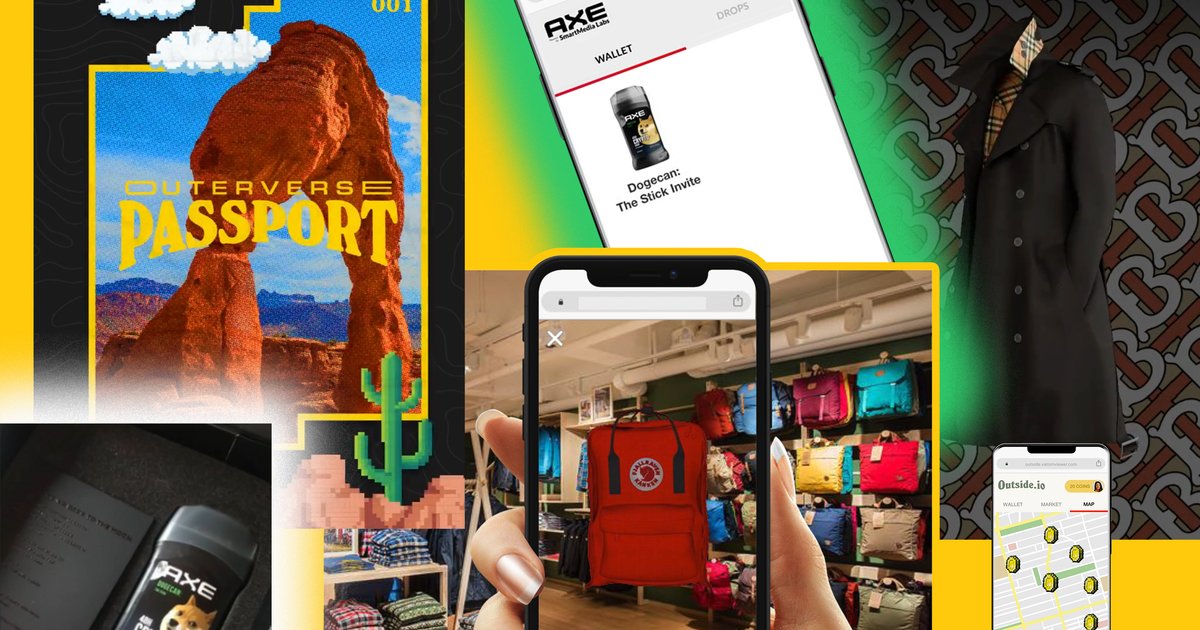Forgot Password?
Once registered, you can:
By registering you agree to our privacy policy, terms & conditions and to receive occasional emails from Ad Age. You may unsubscribe at any time.
Are you a print subscriber? Activate your account.
By Ann-Christine Diaz – 25 min 13 sec ago
By Ad Age and Creativity Staff – 39 min 59 sec ago
By Brian Bonilla – 2 hours 37 min ago
By Ann-Christine Diaz – 3 hours 47 min ago
By Ann-Christine Diaz – 4 hours 44 min ago
By Jade Yan – 1 day 8 hours ago
By Asa Hiken – 1 day 8 hours ago
By Ann-Christine Diaz – 2 days 7 hours ago
By Brian Bonilla – 1 day 1 hour ago
By Ann-Christine Diaz – 2 days 7 hours ago
By Adrianne Pasquarelli – 1 day 2 hours ago
By Jade Yan – 1 day 8 hours ago
By E.J. Schultz – 1 day 7 hours ago
Axe, Burberry, Fjallravens and Outside.io are trying to figure out what to do after the NFT drops.
It took 38 seconds for Axe to sell out of its 100 Dogecans, or what the Unilever brand called “IRL NFTs.” The real deodorant sticks featured a smiling picture of Doge, the Shiba Inu behind the meme-based cryptocurrency, and the deodorant purchase came with a digital receipt to mint an NFT on OpenSea, the NFT marketplace.
It was the second year that Axe promoted its “crypto-scented” deodorant in honor of Dogecoin, but it was the first combined with an NFT. There have been plenty of NFT drops and Web3 activations like these from major brands, but few ways of measuring success. The NFTs drop, they sell out, then brands move on.
“Brands need to think about the importance of KPIs [key performance indicators],” said Asha Susan Cherian, an independent Web3 consultant. “They’re collecting all these wallets and wallet addresses. What’s next?”
In this case, SmartMedia Technologies, a Web3 platform that helps brands develop NFTs and customized wallets, said that the 100 Dogecans sold out. The activation was small, but there were 1,265 wallet signups from people participating. Wallets are digital containers that plug into crypto exchanges and NFT marketplaces so the holders can trade crypto and NFTs and store them.
Crypto-wallets are also viewed as repositories of data. “We see wallets as a new channel for brands being able to connect with their users and engage them,” said Tyler Moebius, CEO of SmartMedia Technologies, which worked with Axe. The wallets are a line into first-party data, which is when a brand gets permission from the consumer to peek into their digital habits and then use that data to market to them later. “We’re able to collect how users interact with NFTs and with their wallets, and to integrate it with Web3 CRMs [customer relationship management platforms],” Moebius said.
Major marketing platforms are starting to develop technologies for brands to manage their NFT programs. This summer, Salesforce, the software marketing giant, launched an NFT Cloud for brands to “deepen loyalty with virtual connections” and “mint NFTs using your CRM and sell on your existing commerce site.” Brands collect customer information such as email addresses, through the NFT campaigns, and then retarget ads and send email offers. NFTs are having a moment in social media too, with Instagram, Twitter and Reddit allowing users to integrate wallets with their profiles. Cherian thinks it could be another data source for those sites to understand their users, helping feed the marketing machine.
“You can utilize wallet addresses to glean all kinds of insights about the consumer,” Cherian said. The contents of a person’s wallets could show the brands they love or even how much disposable income they have, particularly if they own one of the rarer NFTs, like Bored Ape Yacht Club or CryptoPunks. “The reason these companies are creating branded wallets is precisely for data purposes,” Cherian said. “They’re making an assumption that they’ll be able to get more customer data.”
There is a debate right now within the marketing community about whether NFT drops and other Web3 activations are a passing fad or leading to a new kind of advertising. The topic has become even more relevant with “crypto-winter” setting in, which has been marked by a decrease in NFT sales on marketplaces like OpenSea. Also, Bitcoin and Ethereum, which is the main cryptocurrency used in NFT sales, have dropped precipitously in value this year. Crypto exchanges and currencies, once buzzing with celebrity endorsements, have lost their shine. And there are worries about a general economic slowdown, which could force brands to abandon experimental marketing like NFTs and blockchain-based gambles.
“NFTs, they showed up, they made themself known and garnered a certain cultural center of gravity, but they really didn’t deliver on the promise,” said Craig Elimeliah, chief experience design officer at VMLY&R.
Elimeliah is working with brands to create strategies for the coming metaverse and Web3, the next-generation computing platform that would supplant the social media platforms and walled gardens from Web 2.0. In Web3, NFTs have a role, but it’s not about one drop, Elimeliah said. To have a proper Web3 plan, “you have to show that you’ve thought through the first steps,” Elimeliah said.
Moebius of SmartMedia agrees, and said brands have “expanded their view.” The NFT activations are becoming more of a gateway to customer loyalty programs and experiences, either in the real world or in digital realms.
Unilever declined to comment for the story, but the company has been poking and prodding at the NFT space. Last year, Unilever’s Ben & Jerry’s worked with SmartMedia to create a branded wallet for people to collect ice cream-themed NFTs, which could be used to redeem prizes in stores. SmartMedia said 52,000 NFTs were scooped up, leading to 46,000 registered users.
Meanwhile, outerwear brand Fjallravens has mounted an “always-on Web3” ad campaign for four years. The Swedish apparel brand created a branded wallet, which customers use to collect NFTs and unlock in-store rewards. So far, there have been about 750,000 registered users. SmartMedia has run similar campaigns with Burberry and Outside.io, the NFT-based community created by publisher Outside Inc.
In June, Outiside.io launched its NFT program called the “Outerverse Passport,” which generated more than 15,000 wallet signups, according to SmartMedia. The marketing push was billed as an “anti-metaverse” event because it encouraged novice NFT collectors to participate in outdoorsy activities and special events, creating a real-world element. The NFTs are meant to be used as “passports” to access services, products and events. Oustide.io generated $127,000 from passport sales, SmartMedia said.
In Burberry’s case, it created a branded wallet for people to collect “digital twins” of its popular raincoats, which are NFT-based apparel. “The designers of the future will not only be dealing in cloth but will be dealing in code,” Moebius said.
Elimeliah said that brands are just getting their footing in how NFTs connect to communities, which connect to Web3 and the real world. “We will see smart brands doing that in a way where they are reinventing themselves,” Elimeliah said. “And I don’t think it’s going be limited to the metaverse, it has to happen in the real world, too.”
In this article:
Garett Sloane is Ad Age’s technology, digital and media reporter. He has worked in newspapers from Albany to New York City, and small towns in between. He has also worked at every advertising industry trade publication that matters, and he once visited Guatemala and once rode the Budapest Metro.


